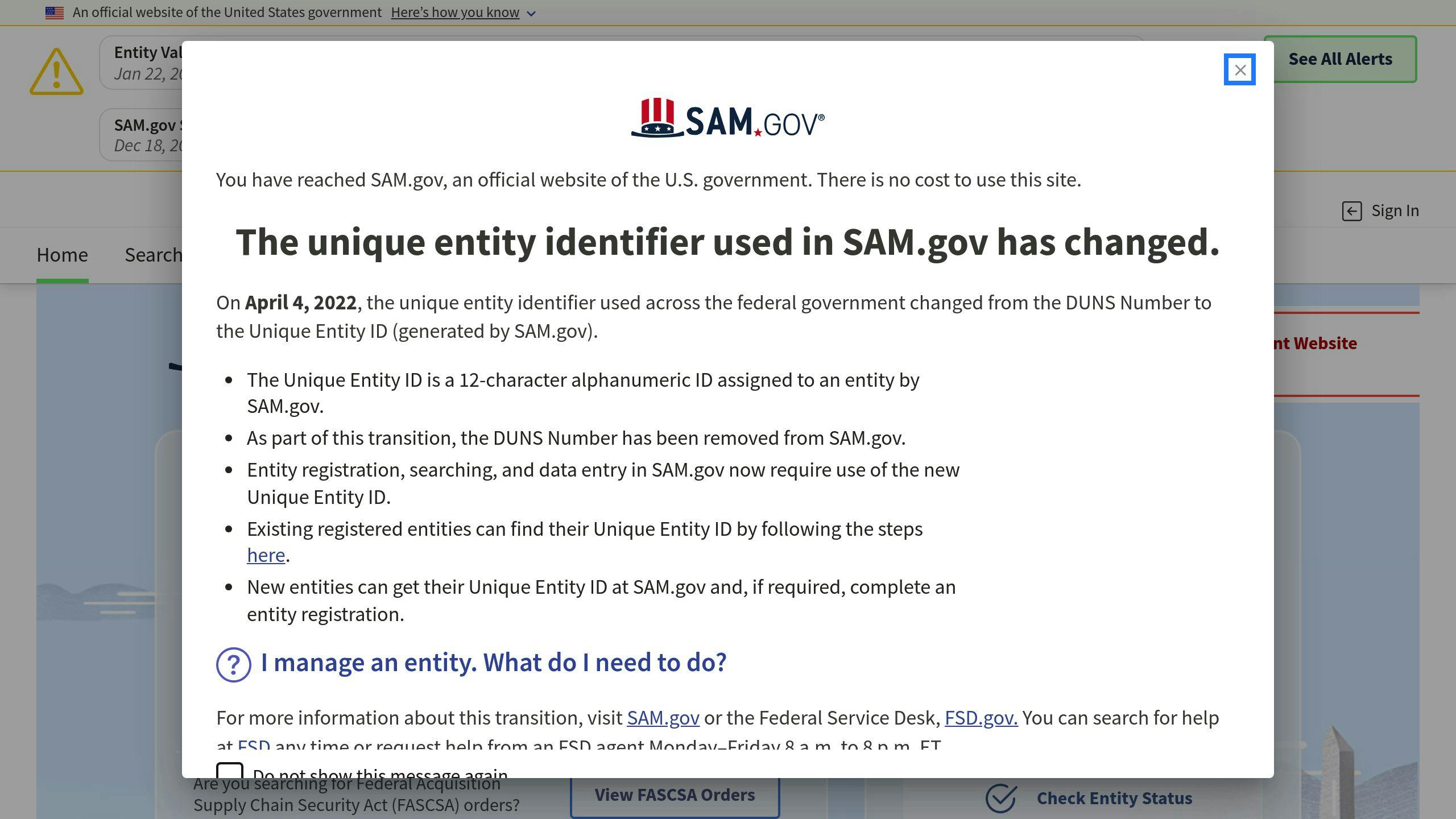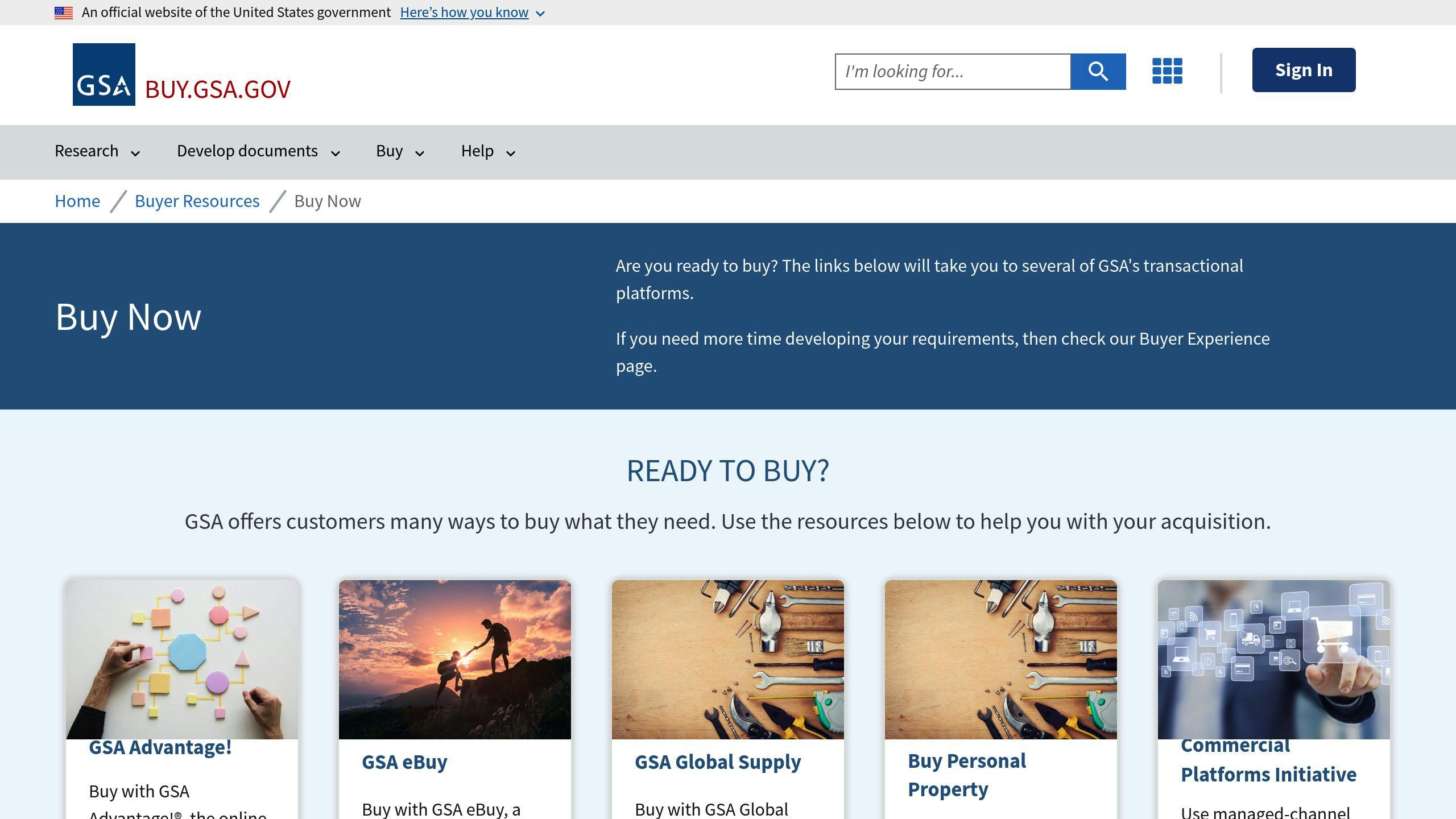Want to sell to the U.S. government through a GSA Schedule? Here’s a quick breakdown of the process:
- What is a GSA Schedule? It’s a government contract allowing businesses to sell products and services to federal agencies at pre-negotiated prices.
- How long does it take? Typically 6–12 months, but it depends on your industry and preparation. IT categories may take 3–4 months, while others like Furniture can take over a year.
- Key steps:
- Preparation: Ensure eligibility, register on SAM.gov, and gather documents (financials, compliance certifications, etc.).
- Submission: Submit your offer via the eOffer system, including pricing, technical, and administrative proposals.
- Review & Negotiation: GSA reviews your submission, negotiates pricing, and finalizes terms.
- Approval & Post-Award: Set up your GSA Advantage listing and market to federal buyers.
Pro tip: Avoid delays by organizing documents, staying responsive, and ensuring compliance with GSA requirements.
Quick Timeline Overview
| Phase | Duration | Key Activities |
|---|---|---|
| Preparation | 1–2 months | Eligibility checks, document collection |
| Submission | 2–3 months | Proposal submission via eOffer |
| Review & Approval | 4–12 months | GSA review, negotiations, and finalization |
| Post-Award | Ongoing | Marketing, compliance, and contract management |
Follow these steps to navigate the GSA Schedule process efficiently and unlock federal contracting opportunities.
How Long Does It Take To Get A GSA Schedule?
Getting Ready: Preparation Steps
Laying the groundwork is key to a smooth GSA Schedule application process and can greatly influence how long the process takes.
Check Eligibility and Readiness
Before diving in, make sure your business meets these basic requirements:
| Requirement | Specification |
|---|---|
| Operational Stability | At least 2 years in business with $100,000 in annual revenue |
| Past Performance | Positive references and a satisfactory performance evaluation |
| Product/Service | Must be commercially available and compliant with the Trade Agreements Act (TAA) |
Taking the GSA Readiness Assessment can help you pinpoint any gaps or areas needing improvement.
"Achieving GSA approval signifies that an organization has successfully met the rigorous standards established by the U.S. General Services Administration (GSA) to provide products or services to the federal government." – Price Reporter
Register on SAM.gov

Starting in April 2022, the registration process includes:
- Creating a Login.gov account and obtaining a Unique Entity ID (UEI).
- Completing your SAM.gov profile with accurate details like revenue, employee count, and tax classification.
- Choosing the correct NAICS codes for your business.
Be cautious – small errors here can cause delays in your application.
Collect Required Documents
You’ll need to gather several key documents, including:
- Financial Documentation: Balance sheets, profit and loss statements, and proof of financial stability for the last two years.
- Compliance and Certification:
- Pathways to Success Training Certificate
- Completed SAM Profile with FAR Report
- Documentation proving compliance with the Trade Agreements Act (TAA)
- Business Capability Evidence:
- A narrative detailing your corporate experience
- Documentation for at least two projects per SIN (Special Item Number)
- A narrative outlining your quality control strategies
- Pricing structure details
Working with GSA consultants can ensure your documents are accurate and meet all requirements. On average, preparation takes about 4–6 weeks, but this effort helps avoid unnecessary delays.
Once everything is ready, the next step is submitting your offer to the GSA.
Submitting Your Offer to GSA
Once your documents are ready, the next step is to submit your offer using the GSA’s eOffer system. This online platform simplifies the process and eliminates the need for physical paperwork.
Prepare Administrative Forms
You’ll need to include several key documents in the administrative section:
| Required Document | Purpose |
|---|---|
| Cover Letter | Introduces your company and summarizes your offer. |
| Authorization and Contact Details | Identifies negotiators and the primary contact. |
| Disclosure Statement | Outlines any potential conflicts of interest. |
| Small Business Subcontracting Plan | Only required for large businesses. |
Write a Technical Proposal
Your technical proposal should demonstrate your ability to deliver the products or services you’re offering. Here’s what to include:
Technical Documentation Requirements
- Details about your company’s experience and expertise.
- Information on your quality control processes, such as internal reviews, performance monitoring, subcontractor management, and customer feedback mechanisms.
- Past performance documentation, such as three CPARS reports or Past Performance Questionnaires, along with customer references for each SIN (Special Item Number).
Create a Pricing Proposal
Pricing is a critical part of your submission. Here’s what you’ll need:
| Component | Description |
|---|---|
| PPT | A list of products/services with pricing. |
| Market Pricing | Commercial rates and justification for pricing. |
| EPA | Method for future price adjustments. |
Key pricing factors to consider:
- Competitor pricing based on market research.
- Your commercial pricing practices.
- Compliance with Federal Acquisition Regulation (FAR) Part 15.
- Offering potential volume discounts.
Make sure to provide solid pricing justifications. Since pricing can be complex, it might be worth consulting an expert to ensure accuracy.
After you submit your offer, the GSA will review your documents and pricing strategy as part of their evaluation process.
Review and Negotiation Process
After submitting your GSA Schedule offer through eOffer, your proposal goes through an evaluation phase that typically lasts 6-12 months. This process ensures your proposal meets GSA standards and positions your business for success in the federal marketplace.
GSA Review and Feedback
The GSA carefully reviews your proposal to evaluate its completeness, financial stability, technical capabilities, and pricing. Each step, from initial checks to pricing analysis, ensures your offer is compliant and competitive. The GSA assesses proposals based on five key factors: Completeness, Scope, Responsibility, Subcontracting, and Proposed MAS Pricing.
Once the review is complete, the focus shifts to negotiating terms and finalizing the proposal.
Negotiate Terms and Pricing
The Contracting Officer (CO) works to secure favorable terms for the government, such as discounts for prompt payments, bulk purchases, or adjustments to pricing. To do this, the CO compares your rates with competitors in the same Schedule and SINs using pricing tools.
"It’s the CO’s job to try and get the best price for the government." – Winvale Team
To prepare for these discussions, research competitor pricing, gather documentation to justify your rates, and set clear pricing boundaries while staying flexible.
Submit Final Proposal Revisions
Most GSA offers require minor updates before they are approved. Your final revised proposal should include all agreed-upon changes, such as:
- Pricing structure
- Discount terms
- Service offerings
- Delivery conditions
"It’s rare for a GSA offer to go through without at least some minor changes before the award of a GSA contract."
Around half of all self-prepared GSA Schedule proposals are rejected due to issues like formatting errors, incomplete documentation, or failure to address GSA feedback. Partnering with GSA Schedule experts, such as GSA Focus, can help you avoid these pitfalls and keep the process moving forward.
Once your final revisions are submitted, the approval process nears completion, bringing you closer to securing your GSA Schedule.
sbb-itb-8737801
After Approval: Using Your GSA Schedule
Set Up Your GSA Advantage Listing

Once your contract is approved, the first step is setting up your GSA Advantage listing. Allow 24 hours after the award for GSA systems to process your contract details.
Create detailed product listings that include UPCs, MPNs, photos, and specifications. Use relevant keywords and industry-standard terms to make your products easier to find in the GSA Advantage database.
"Government agencies can easily search for millions of products and services, yours included." – GSA Schedule Marketing 101
Plan for Federal Market Success
Getting a GSA Schedule is just the start. To secure federal business, you’ll need to actively market your offerings and build relationships. The government won’t automatically buy from you just because you have a Schedule contract.
Key marketing strategies include:
- GSA eBuy: Check daily RFQs and RFPs under your SINs.
- Agency Events: Participate in industry days and capability briefings.
- Website Updates: Add a dedicated section for government buyers.
- Market Research: Use GSA’s Acquisition Gateway to forecast opportunities.
If you qualify as a small business, take advantage of set-aside programs. The government has specific purchasing goals for small businesses, which can open doors for GSA Schedule holders.
Manage Compliance and Contracts
Staying compliant is crucial for maintaining your GSA Schedule and reaping its benefits. Keep a close eye on sales reporting, pricing rules, catalog updates, and mass modifications to ensure you meet contract obligations.
"The risks of non-compliance can be, at best, an annoyance. At worst, a company can incur heavy fines, risk contract termination and possibly even disbarment from bidding on future federal contracts." – Fedmarket
Consider setting up a GSA Compliance Program to track all requirements efficiently. Tools like GSA eContractManager can help you monitor deadlines and key contract benchmarks, ensuring nothing gets overlooked.
Ways to Speed Up the GSA Schedule Process
Common Mistakes to Avoid
Delays in the GSA Schedule process often stem from avoidable errors. A frequent issue is submitting incomplete or outdated documentation. For example, financial statements must be up-to-date, and all required certifications should be thoroughly documented.
Another stumbling block is failing to prepare for Trade Agreements Act (TAA) compliance. Ignoring this requirement can lead to time-consuming revisions. Errors in technical proposals are another major cause of delays. Your proposal needs to clearly show how your products or services align with the Special Item Numbers (SINs) you’ve chosen, along with detailed capability statements.
Get Help from Experts
Expert guidance can make the GSA Schedule process smoother and faster. GSA consultants, like those at GSA Focus, can help you navigate the complexities, making sure your submission is accurate and reducing the back-and-forth with reviewers. Their experience is especially valuable during critical stages like financial reviews and pricing negotiations, where expertise can save significant time.
Steps for Faster Approval
If you’re looking to speed up your GSA Schedule approval, concentrate on these key areas:
- Start Early: Begin your SAM.gov registration as soon as possible – processing can take several weeks.
- Organize Your Documents: Ensure you have a complete package, including financial statements, past performance reports, pricing information, and compliance certifications.
- Stay Responsive: Quickly address any GSA requests or questions to keep the process moving.
For Industrial Products and Services categories, which often require more extensive documentation, being well-prepared is even more crucial. These applications can take up to a year from submission to approval [3], but careful planning can significantly reduce delays.
While the average timeline is 6–12 months, focusing on preparation and attention to detail can help you shorten it [1]. Submitting a polished MAS offer that highlights your strengths and meets all compliance requirements upfront is key to avoiding unnecessary setbacks.
Conclusion: Steps to a Successful GSA Schedule
Overview of the GSA Schedule Process
Securing a GSA Schedule involves four key phases, each building on the previous one. It starts with the Preparation Phase, where businesses verify eligibility and complete their registration on SAM.gov. Next comes the Submission Phase, where detailed proposals – covering administrative, technical, and pricing aspects – are prepared. The Review Phase follows, lasting 4-12 months [5], during which the GSA carefully evaluates and negotiates contract terms. Finally, the Post-Approval Phase ensures ongoing compliance and management of the contract.
In total, the process typically takes 6–12 months, with each phase requiring focused effort:
- Preparation: 1-2 months
- Submission: 2-3 months
- Review: 4-12 months
- Post-Approval: Ongoing
Understanding this structure allows businesses to better plan their approach and allocate resources effectively.
Final Advice for Success
The GSA Schedule process is detailed and time-intensive, demanding thorough preparation and execution. To ease the journey, the Office of Small Business Utilization offers resources like online courses and training materials [4]. These tools can help you better understand federal market requirements and stay compliant.
Key steps to keep in mind:
- Keep your documentation current and organized.
- Set up systems to track compliance requirements.
- Take advantage of GSA tools like the Vendor Support Center [4].
Given the 6–12 month timeline [1], many businesses find it helpful to work with professional consultants. Their expertise can simplify complex requirements and help avoid delays or rejections.
FAQs
How long does it take to get on GSA?
The time it takes to secure a GSA Schedule varies based on factors like the complexity of your offer, the quality of your submission, and the specific Large Category you’re applying under. For IT companies, the FASt Lane program can speed up the process to about 3-6 months by simplifying reviews and approvals. On the other hand, applications under Industrial Products and Services (Large Category E) generally take longer because of their extensive catalog requirements [3].
Knowing these timelines can help you allocate resources wisely and avoid unnecessary delays during the application process.
What is the timeline for GSA approval?
The GSA approval process is broken into several phases, each with its own timeline:
| Review Phase | Typical Duration | Key Activities |
|---|---|---|
| Preliminary Review | 1-2 months | Initial review for compliance |
| Financial Review | 1-3 months | Assessment of financial stability |
| Price Negotiation | 2-4 months | Negotiations to determine fair pricing |
| Final Processing | 2-3 months | Contract finalization and approval |
"The GSA review process includes preliminary review, financial review, and determining ‘fair and reasonable’ pricing and negotiation. After submission, a contracting professional will review your offer, clarify any questions or issues, correct errors, and negotiate pricing if necessary" [2].
Your timeline will largely depend on how well you understand GSA regulations and how complete your submission is. Working with experienced consultants can help streamline the process and avoid setbacks [3]. For more details on each phase, check out the ‘Review and Negotiation Process’ section above.
Being aware of these timelines and steps will help you prepare for each stage of your GSA Schedule application journey.
Related Blog Posts
- GSA Schedule Contract Renewal: Key Requirements
- How to Track GSA Contract Compliance
- How to Read GSA Solicitation Documents
- How to Manage GSA Contract Performance


